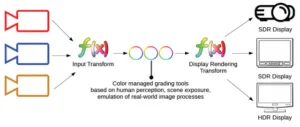In a paper presented by Peter Postma and a team from FilmLight, Postma started by noting that colorists first spend a lot of time color matching content from different cameras before creating the HDR and SDR grades. This is very time consuming, so he suggested colorists should use ACES-defined input device transforms (IDTs) for the cameras to aid in camera matching and display rendering transforms to aid in creating the HDR and SDR masters.
On the display side, Postma noted that the mastering display will not have the same color gamut or luminance range capabilities to reproduce the color and light from the original scene. A display rendering transform (DRT) provides this mapping and are typically implemented in Lookup Tables (LUTs). These are useful for creating a quick “look” but often must be modified by the colorist for the final image. This can be implemented before or after the DRT in the production workflow, but changing the DRT to fit another output display will change the final image. This is the problem that Postma addressed in his paper.
He then described their new Base Grade color correction grading tool that operates quite differently from traditional tools. It relies on the camera IDTs and DRTs but uses a new internal color space that mimics the color processing of the human eye to perform the grading operations.
In their system, color is first converted to the LMS primaries that the human eye creates when we see light. This consists of an achromatic luminance “A” channel and two color components “a” and “b”. In operation, the colorist first adjusts the zero energy black point for the image that becomes the darkest value produced on the display through the DRT. Next, the colorist balances the overall image using exposure and color balance controls. The exposure knob adjusts linear light in channel A while the color balance knob provides color temperature changes via channels a and b, with these adjustments perceptually weighted to be uniform in all directions over the full range of luminance.
Contrast and saturation controls then allow the colorists to adjust the ratio scene contrast to display contrast and to modify colorfulness. Base Grade allows for four zones where these setting can be adjusted separately. As above, contrast manipulates the A channel and saturation the a and b channels.
These new controls can work in parallel with the familiar, traditional color grading tools, but Postma thinks that as colorists learn how to use the new tools and provide feedback for additional development, this more modern approach to grading, driven by the demands of HDR grading, will all but replace the legacy tools. – CC

